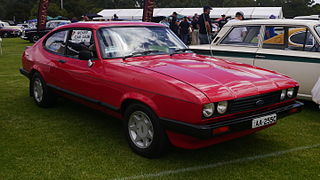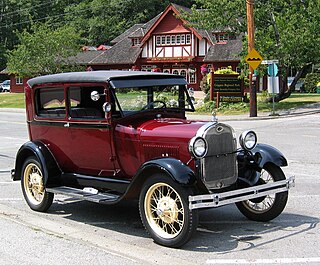
The Ford Taunus is a family car that was sold by Ford Germany throughout Europe. Models from 1970 onward were built on the same basic construction as the Ford Cortina MkIII in the United Kingdom, and later on, the two car models were essentially the same, differing almost only in the placement of the steering wheel. The model line was named after the Taunus mountain range in Germany, and was first made in 1939, and continued through several versions until 1994.

A straight-three engine is a three-cylinder piston engine where cylinders are arranged in a line along a common crankshaft.
Yamaha Motor Co., Ltd. is a Japanese mobility manufacturer that produces motorcycles, motorboats, outboard motors, and other motorized products. The company was established in the year 1955 upon separation from Nippon Gakki Co., Ltd. and is headquartered in Iwata, Shizuoka, Japan. The company conducts development, production and marketing operations through 109 consolidated subsidiaries as of 2012.

The term 1932 Ford may refer to three models of automobile produced by Ford Motors between 1932 and 1934: the Model B, the Model 18, and the Model 40. These succeeded the Model A. The Model B had an updated four-cylinder engine and was available from 1932 to 1934. The V8 was available in the Model 18 in 1932, and in the Model 40 in 1933 & 1934. The 18 was the first Ford fitted with the flathead V-8. The company also replaced the Model AA truck with the Model BB, available with either the four- or eight-cylinder engine.

The Ford Köln is an automobile that was produced by Ford Germany from 1933 until 1936 at its Cologne plant.

The Ford Capri is a fastback coupé built by Ford of Europe, designed by Philip T. Clark, who was also involved in the design of the Ford Mustang. It used the mechanical components from the Mk2 Ford Cortina and was intended as the European equivalent of the Ford Mustang. The Capri went on to be highly successful for Ford, selling nearly 1.9 million units in its lifetime. A wide variety of engines were used in the car throughout its production lifespan, which included the Essex and Cologne V6 at the top of the range, while the Kent straight-four and Taunus V4 engines were used in lower-specification models. Although the Capri was not officially replaced, the second-generation Probe was effectively its replacement after the later car's introduction to the European market in 1994.
Economy car is a term mostly used in the United States for cars designed for low-cost purchase and operation. Typical economy cars are small, lightweight, and inexpensive to both produce and purchase. Stringent design constraints generally force economy car manufacturers to be inventive. Many innovations in automobile design were originally developed for economy cars, such as the Ford Model T and the Austin Mini.

An overhead camshaft (OHC) engine is a piston engine in which the camshaft is located in the cylinder head above the combustion chamber. This contrasts with earlier overhead valve engines (OHV), where the camshaft is located below the combustion chamber in the engine block.

In automotive engineering a multi-valve or multivalve engine is one where each cylinder has more than two valves. A multi-valve engine has better breathing and may be able to operate at higher revolutions per minute (RPM) than a two-valve engine, delivering more power.

The Ford flathead V8 is a V8 engine with a flat cylinder head designed by the Ford Motor Company and built by Ford and various licensees. During the engine's first decade of production, when overhead-valve engines were used by only a small minority of makes, it was usually known simply as the Ford V‑8, and the first car model in which it was installed, the Model 18, was often called simply the "Ford V-8", after its new engine. Although the V8 configuration was not new when the Ford V8 was introduced in 1932, the latter was a market first in the respect that it made an 8-cylinder affordable and a V engine affordable to the emerging mass market consumer for the first time. It was the first independently designed and built V8 engine produced by Ford for mass production, and it ranks as one of the company's most important developments. A fascination with ever-more-powerful engines was perhaps the most salient aspect of the American car and truck market for a half century, from 1923 until 1973. The engine was intended to be used for big passenger cars and trucks; it was installed in such until 1953, making the engine's 21-year production run for the U.S. consumer market longer than the 19-year run of the Ford Model T engine for that market. The engine was on Ward's list of the 10 best engines of the 20th century. It was a staple of hot rodders in the 1950s, and it remains famous in the classic car hobbies even today, despite the huge variety of other popular V8s that followed.
The Ford Super Duty engine is a range of V8 engines that were manufactured by Ford Motor Company. Introduced in 1958, the Super Duty engines replaced the Lincoln Y-block V8.

The Ford Model A was the Ford Motor Company's second market success, replacing the venerable Model T which had been produced for 18 years. It was first produced on October 20, 1927, but not introduced until December 2. This new Model A was designated a 1928 model and was available in four standard colors.

The Ford Model 48 was an update on Ford's V8-powered Model 40A, the company's main product. Introduced in 1935, the Model 48 was given a cosmetic refresh annually, begetting the 1937 Ford before being thoroughly redesigned for 1941. The 1935 Ford's combination of price, practicality, and looks vaulted the company ahead of rival Chevrolet for the sales crown that year, with 820,000 sold.

The European Ford Granada is an executive car manufactured by Ford Europe from 1972 until 1994.

The Ford Model C is a car that was produced from 1934 until 1937 by Ford UK in Dagenham. It had an 1172 cc four-cylinder sidevalve engine delivering 34 hp (25 kW). It was the big brother to the smaller Ford Y, which had a 933 cc engine. The styling was inspired by the 1934 Ford V8, only smaller. The Model C was also built by Ford Germany, where it was named the Ford Eifel after the mountain range near Cologne, and it was sold from 1934 to 1940.

In 2015 Spain produced 2.7 million cars which made it the 8th largest automobile producer country in the world and the 2nd largest car manufacturer in Europe after Germany a position in the ranking that it was still keeping in 2024. Approximately 80% of that production is for export. During the first half of 2016, with exports valued over 24 billion euros over that period, the automotive industry accounted for 18.9% of the total Spanish exports.

The Opel Rekord Series B is a large family car that was introduced in August 1965, by Opel as a replacement for the Opel Rekord Series A. The Rekord B shared the wheelbase and 1696mm width of its predecessor, but the front and rear panels were restyled in order effectively to differentiate the new model. The big news was under the bonnet/hood, however.

The Ford FK, short for "Ford Köln," is a series of medium-duty trucks built by Ford of Germany in their Cologne (Köln) plant in two generations from 1951 until 1961. The Ford "Köln" name replaced the earlier Rhein and Ruhr badges as competitor Krupp (Südwerke) had quietly copyrighted them. Ford Germany withdrew from the truck sector after 1961, focusing on lighter utility vehicles and imports from Ford UK.

The Ford Bronco Sport is a compact crossover SUV sold by Ford Motor Company and marketed under the Ford Bronco nameplate. It was released alongside the sixth generation Bronco body-on-frame SUV, featuring a similar retro and off-road styling in a smaller footprint. The vehicle is based on the front-wheel drive-based, unibody C2 platform, which is also used by the Ford Escape crossover and Maverick pickup.
















